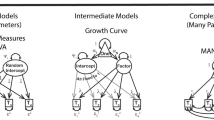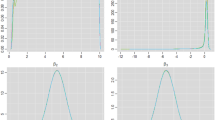Abstract
The prevention sciences often face several situations that can compromise the statistical power and validity of a study. Among these, research can (1) have data with many variables, sometimes with low sample sizes, (2) have highly correlated predictors, (3) have unclear theory or empirical evidence related to the research questions, and/or (4) have difficulty selecting the proper covariates in observational studies. Modeling in these situations is difficult—and at times impossible—with conventional methods. Fortunately, regularized regression—a machine learning technique—can aid in exploring datasets that are otherwise difficult to analyze, allowing researchers to draw insights from these data. Although many of these methods have existed for several decades, prevention researchers rarely use them. As a gentle introduction, we discuss the utility of regularized regression to the field of prevention science and apply the technique to a real dataset. The data (n = 7979) for the demonstration consisted of 76 variables (151 including the modeled interactions) from the Youth Risk-Behavior Surveillance System (YRBSS) from 2015. Overall, it is clear that regularized regression can be an important tool in analyzing and gaining insight from data in the prevention sciences.


Similar content being viewed by others
Notes
Only reporting and discussing significant relationships when many were tested and incurs a high type-I error rate.
It is critical to note that when using the term “important” in this context, it refers to importance in the model’s predictive accuracy. In other words, a variable is important if, in conjunction with the other variables in the model, it is useful in predicting the outcome accurately. This is distinct from the usual discussion of significance and effect size in convention statistics.
All estimates from the elastic net and unbiased models are included in the Supplementary Table.
References
2015 YRBS Data User’s Guide. (2016). https://doi.org/10.1016/j.jadohealth.2016.03.017.
Bécu, J.-M., Grandvalet, Y., Ambroise, C., & Dalmasso, C. (2015). Beyond support in two-stage variable Selection, 1–25. Retrieved from http://arxiv.org/abs/1505.07281. Accessed May 2017
Belloni, A., Chernozhukov, V., & Hansen, C. (2013). Inference on treatment effects after selection among high-dimensional controls. Review of Economic Studies, 81, 608–650. https://doi.org/10.1093/restud/rdt044.
Cumming, G. (2014). The new statistics: Why and how. Psychological Science, 25, 7–29. https://doi.org/10.1177/0956797613504966.
Friedman, J., Hastie, T., & Tibshirani, R. (2010). A note on the group lasso and a sparse group lasso. ArXiv:1001.0736 [Math, Stat], 8. https://doi.org/10.1111/biom.12292
Friedman, J., Hastie, T., Simon, N., & Tibshirani, R. (2016). Package “glmnet”: Lasso and elastic-net regularized general linear models. R Package Version, 23. Retrieved from https://www.jstatsoft.org/article/view/v033i01. Accessed May 2017
Graham, J. W., Olchowski, A. E., & Gilreath, T. D. (2007). How many imputations are really needed? Some practical clarifications of multiple imputation theory. Prevention Science, 8, 206–213. https://doi.org/10.1007/s11121-007-0070-9.
Hastie, T., Tibshirani, R., & Friedman, J. (2009). The elements of statistical learning. Elements (Vol. 1). https://doi.org/10.1007/b94608
Hoerl, A. E., & Kennard, R. W. (1970). Ridge regression: Biased estimation for nonorthogonal problems. Technometrics, 12, 55–67. https://doi.org/10.1080/00401706.1970.10488634.
James, G., Witten, D., Hastie, T., & Tibshirani, R. (2007). An introduction to statistical learning. Performance evaluation (Vol. 64). Springer US. https://doi.org/10.1016/j.peva.2007.06.006
Kessler, R., Warner, C., Ivany, C., Petukhova, M., Rose, S., Bromet, E. J., et al. (2015). Predicting suicides after psychiatric hospitalization in US Army soldiers: The Army Study To Assess Risk and rEsilience in Servicemembers (Army STARRS). JAMA Psychiatry, 72, 49–57. Retrieved from. https://doi.org/10.1001/jamapsychiatry.2014.1754.
Kuhn, M. (2008). Caret package. Journal of Statistical Software, 28(5).
Lockhart, G., Mackinnon, D. P., & Ohlrich, V. (2011). Mediation analysis in psychosomatic medicine research. Psychosomatic Medicine, 73, 29–43. https://doi.org/10.1097/PSY.0b013e318200a54b.Mediation.
McNeish, D. M. (2015). Using lasso for predictor selection and to assuage overfitting: A method long overlooked in behavioral sciences. Multivariate Behavioral Research, 50, 471–484. https://doi.org/10.1080/00273171.2015.1036965.
Pinquart, M., & Shen, Y. (2011). Behavior problems in children and adolescents with chronic physical illness: A meta-analysis. Journal of Pediatric Psychology, 36, 375–384. https://doi.org/10.1093/jpepsy/jsq104.
Sauer, B., Brookhart, M. A., Roy, J. A., & VanderWeele, T. J. (2013). Covariate selection. In P. Velentgas, N. A. Dreyer, P. Nourjah, S. R. Smith, & M. M. Torchia (Eds.), Developing a protocol for observational comparative effectiveness research: A user’s guide (pp. 93–108). Rockville, MD: Agency for Healthcare Research and Quality.
Simon, N., Friedman, J., Hastie, T., & Tibshirani, R. (2013). A sparse-group lasso. Journal of Computational and Graphical Statistics, 22, 231–245. https://doi.org/10.1080/10618600.2012.681250.
Simon, N., Friedman, J., Hastie, T., & Tibshirani, R. (2015). Fit a GLM (or Cox model) with a combination of lasso and group lasso regularization.
Tibshirani, R. (2011). Regression shrinkage and selection via the lasso. Journal of the Royal Statistical Society, 73, 267–288. https://doi.org/10.1111/j.1467-9868.2011.00771.x.
Urminsky, O., Hansen, C., & Chernozhukov, V. (2016). Using double-lasso regression for principled variable selection. Available at SSRN 2733374, 1–70.
Vanderweele, T. J. (2012). Invited commentary: Structural equation models and epidemiologic analysis. American Journal of Epidemiology, 176, 608–612. https://doi.org/10.1093/aje/kws213.
Wooldridge, J. M. (2013). Introductory econometrics (4th ed.). Mason, OH: South-Western Cengage Learning. https://doi.org/10.1016/j.jconhyd.2010.08.009.
Zhao, Y., & Luo, X. (2016). Pathway lasso: Estimate and select sparse mediation pathways with high dimensional mediators. Retrieved from http://arxiv.org/abs/1603.07749
Zou, H. (2006). The adaptive lasso and its oracle properties. Journal of the American Statistical Association, 101, 1418–1429. https://doi.org/10.1198/016214506000000735.
Zou, H., & Hastie, T. (2005). Regularization and variable selection via the elastic net. Journal of the Royal Statistical Society, 67, 301–320.
Zou, H., & Zhang, H. H. (2009). On the adaptive elastic-net with a diverging number of parameters. Annals of Statistics, 37, 1733–1751. https://doi.org/10.1214/08-AOS625.ON.
Author information
Authors and Affiliations
Corresponding author
Ethics declarations
Conflict of Interest
The authors declare that they have no conflict of interest.
Ethical Approvals
The present study uses data collected through the direction of the Centers for Disease Control and Prevention. As such, the proper ethical approvals were obtained through its supervision.
Informed Consent
As in part three above, the Centers for Disease Control and Prevention were in charge of supervising the informed consent of each of the subjects.
Additional information
Publisher’s Note
Springer Nature remains neutral with regard to jurisdictional claims in published maps and institutional affiliations.
Electronic Supplementary Material
ESM 1
(DOCX 26 kb)
Rights and permissions
About this article
Cite this article
Barrett, T.S., Lockhart, G. Efficient Exploration of Many Variables and Interactions Using Regularized Regression. Prev Sci 20, 575–584 (2019). https://doi.org/10.1007/s11121-018-0963-9
Published:
Issue Date:
DOI: https://doi.org/10.1007/s11121-018-0963-9




